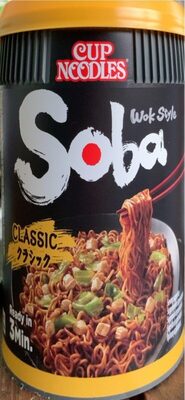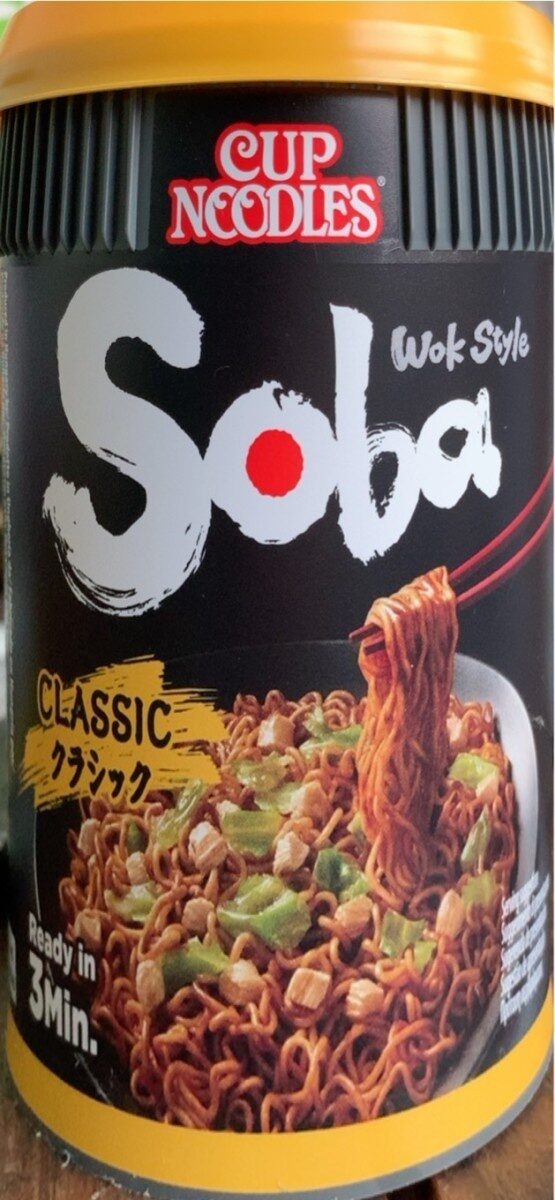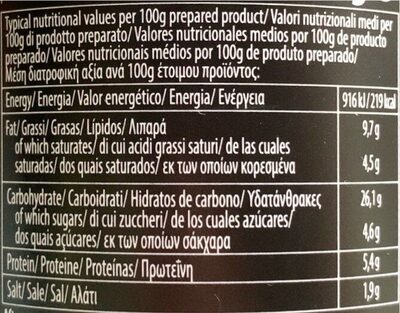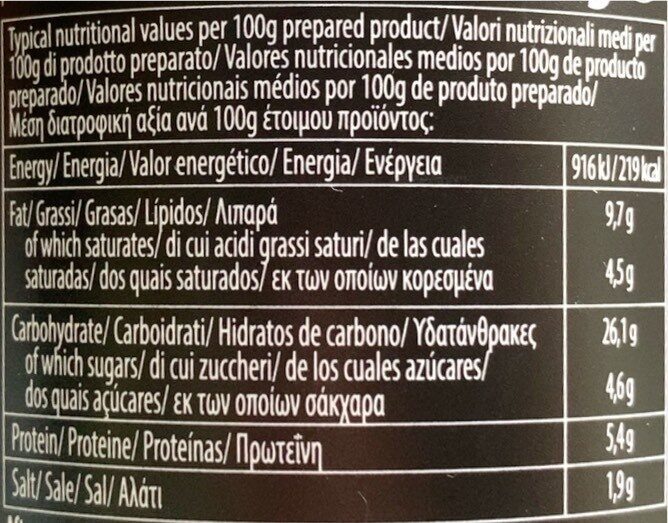Ajuda'ns a fer que la transparència alimentària sigui la norma!
Com a organització sense ànim de lucre, depenem de les vostres donacions per continuar informant els consumidors de tot el món sobre tot allò què mengen.
La revolució alimentària comença amb tu!
Soba Classic Noodles - Nissin - 90 g
Soba Classic Noodles - Nissin - 90 g
Aquesta pàgina del producte no està completa. Podeu ajudar a completar-la editant-la i afegint-hi més dades a partir de les fotos ja disponibles, o fent-ne més amb l'aplicació de androide o iPhone / iPad. Gràcies!
×
Codi de barres: 5997523315511 (EAN / EAN-13)
Quantitat: 90 g
Empaquetament: en:pp-lid, en:pp-tub
Marques: Nissin
Categories: Aliments i begudes amb base vegetal, Aliments amb base vegetal, Cereals i patates, Cereals i derivats, Menjar preparat, Productes secs, Plats de pasta, Pasta, Productes assecats per a ser rehidratats, Fideus, en:Instant noodles, en:Chinese noodles
Matching with your preferences
Salut
Ingredients
-
35 ingredients
Anglès: noodles 72,3%: wheat flour, palm oil salt, flavour enhancer e621, flour treatment agents (e500,e451), antioxidant e306, acidity regulator, citric acid), seasoning sauce 19,9% (sugar, rapeseed oil, soy sauce (water, soybean, salt, wheat), flavour enhancers (e621, e635, dextrose, molasses, vinegar, salt, spices, hydrolysed vegetable protein, tomato powder, acidiity regulator: citric acid, flavouring], cabbage, chicken meat cubeAl·lèrgens: en:Crustaceans, en:Fish, en:Gluten, en:Milk, en:Molluscs, en:Mustard, en:Sesame seeds, en:Soybeans
Processament d'aliments
-
Aliments ultra processats
Elements que indiquen que el producte està al grup 4 - Aliments i begudes ultraprocessats:
- Additiu: E451 - Trifosfat
- Additiu: E621 - Glutamat de monosodi
- Additiu: E635 - 5'-ribonucleòtid de disodi
- Ingredient: Dextrosa
- Ingredient: Potenciador del gust
- Ingredient: Aromes
- Ingredient: Glucosa
Els productes alimentaris es classifiquen en 4 grups segons el seu grau de processament:
- Aliments no processats o mínimament processats
- Ingredients culinaris processats
- Aliments processats
- Aliments ultra processats
La determinació del grup es fa en funció de la categoria del producte i dels ingredients que conté.
Additius
-
E330 - Acid citric
Citric acid: Citric acid is a weak organic acid that has the chemical formula C6H8O7. It occurs naturally in citrus fruits. In biochemistry, it is an intermediate in the citric acid cycle, which occurs in the metabolism of all aerobic organisms. More than a million tons of citric acid are manufactured every year. It is used widely as an acidifier, as a flavoring and chelating agent.A citrate is a derivative of citric acid; that is, the salts, esters, and the polyatomic anion found in solution. An example of the former, a salt is trisodium citrate; an ester is triethyl citrate. When part of a salt, the formula of the citrate ion is written as C6H5O3−7 or C3H5O-COO-3−3.Origen: Wikipedia (Anglès)
-
E451 - Trifosfat
Sodium triphosphate: Sodium triphosphate -STP-, also sodium tripolyphosphate -STPP-, or tripolyphosphate -TPP-,- is an inorganic compound with formula Na5P3O10. It is the sodium salt of the polyphosphate penta-anion, which is the conjugate base of triphosphoric acid. It is produced on a large scale as a component of many domestic and industrial products, especially detergents. Environmental problems associated with eutrophication are attributed to its widespread use.Origen: Wikipedia (Anglès)
-
E500 - Carbonats de sodi
Sodium carbonate: Sodium carbonate, Na2CO3, -also known as washing soda, soda ash and soda crystals, and in the monohydrate form as crystal carbonate- is the water-soluble sodium salt of carbonic acid. It most commonly occurs as a crystalline decahydrate, which readily effloresces to form a white powder, the monohydrate. Pure sodium carbonate is a white, odorless powder that is hygroscopic -absorbs moisture from the air-. It has a strongly alkaline taste, and forms a moderately basic solution in water. Sodium carbonate is well known domestically for its everyday use as a water softener. Historically it was extracted from the ashes of plants growing in sodium-rich soils, such as vegetation from the Middle East, kelp from Scotland and seaweed from Spain. Because the ashes of these sodium-rich plants were noticeably different from ashes of timber -used to create potash-, they became known as "soda ash". It is synthetically produced in large quantities from salt -sodium chloride- and limestone by a method known as the Solvay process. The manufacture of glass is one of the most important uses of sodium carbonate. Sodium carbonate acts as a flux for silica, lowering the melting point of the mixture to something achievable without special materials. This "soda glass" is mildly water-soluble, so some calcium carbonate is added to the melt mixture to make the glass produced insoluble. This type of glass is known as soda lime glass: "soda" for the sodium carbonate and "lime" for the calcium carbonate. Soda lime glass has been the most common form of glass for centuries. Sodium carbonate is also used as a relatively strong base in various settings. For example, it is used as a pH regulator to maintain stable alkaline conditions necessary for the action of the majority of photographic film developing agents. It acts as an alkali because when dissolved in water, it dissociates into the weak acid: carbonic acid and the strong alkali: sodium hydroxide. This gives sodium carbonate in solution the ability to attack metals such as aluminium with the release of hydrogen gas.It is a common additive in swimming pools used to raise the pH which can be lowered by chlorine tablets and other additives which contain acids. In cooking, it is sometimes used in place of sodium hydroxide for lyeing, especially with German pretzels and lye rolls. These dishes are treated with a solution of an alkaline substance to change the pH of the surface of the food and improve browning. In taxidermy, sodium carbonate added to boiling water will remove flesh from the bones of animal carcasses for trophy mounting or educational display. In chemistry, it is often used as an electrolyte. Electrolytes are usually salt-based, and sodium carbonate acts as a very good conductor in the process of electrolysis. In addition, unlike chloride ions, which form chlorine gas, carbonate ions are not corrosive to the anodes. It is also used as a primary standard for acid-base titrations because it is solid and air-stable, making it easy to weigh accurately.Origen: Wikipedia (Anglès)
-
E621 - Glutamat de monosodi
Monosodium glutamate: Monosodium glutamate -MSG, also known as sodium glutamate- is the sodium salt of glutamic acid, one of the most abundant naturally occurring non-essential amino acids. Glutamic acid is found naturally in tomatoes, grapes, cheese, mushrooms and other foods.MSG is used in the food industry as a flavor enhancer with an umami taste that intensifies the meaty, savory flavor of food, as naturally occurring glutamate does in foods such as stews and meat soups. It was first prepared in 1908 by Japanese biochemist Kikunae Ikeda, who was trying to isolate and duplicate the savory taste of kombu, an edible seaweed used as a base for many Japanese soups. MSG as a flavor enhancer balances, blends, and rounds the perception of other tastes.The U.S. Food and Drug Administration has given MSG its generally recognized as safe -GRAS- designation. A popular belief is that large doses of MSG can cause headaches and other feelings of discomfort, known as "Chinese restaurant syndrome," but double-blind tests fail to find evidence of such a reaction. The European Union classifies it as a food additive permitted in certain foods and subject to quantitative limits. MSG has the HS code 29224220 and the E number E621.Origen: Wikipedia (Anglès)
Anàlisi dels ingredients
-
No conté oli de palma
No s'han detectat ingredients que continguin oli de palma
Ingredients no reconeguts: en:palm-oil-salt, en:seasoning-sauce, en:acidiity-regulator, en:chicken-meat-cubeAlguns ingredients no s'han pogut reconèixer.
Necessitem la teva ajuda!
Podeu ajudar-nos a reconèixer més ingredients i analitzar millor la llista d'ingredients d'aquest producte i d'altres mitjançant:
- Editeu aquesta pàgina de producte per corregir les faltes d’ortografia de la llista d’ingredients i/o per eliminar els ingredients d’altres idiomes i frases que no estiguin relacionades amb els ingredients.
- Afegiu entrades, sinònims o traduccions noves a les nostres llistes multilingües d’ingredients, mètodes de processament d’ingredients i etiquetes.
Uniu-vos al canal #ingredients del nostre espai de discussió a Slack i/o apreneu sobre l'anàlisi dels ingredients en la nostra wiki, si voleu ajudar. Gràcies!
-
Es desconeix si és vegà
Ingredients no reconeguts: en:palm-oil-salt, en:seasoning-sauce, en:acidiity-regulator, en:chicken-meat-cubeAlguns ingredients no s'han pogut reconèixer.
Necessitem la teva ajuda!
Podeu ajudar-nos a reconèixer més ingredients i analitzar millor la llista d'ingredients d'aquest producte i d'altres mitjançant:
- Editeu aquesta pàgina de producte per corregir les faltes d’ortografia de la llista d’ingredients i/o per eliminar els ingredients d’altres idiomes i frases que no estiguin relacionades amb els ingredients.
- Afegiu entrades, sinònims o traduccions noves a les nostres llistes multilingües d’ingredients, mètodes de processament d’ingredients i etiquetes.
Uniu-vos al canal #ingredients del nostre espai de discussió a Slack i/o apreneu sobre l'anàlisi dels ingredients en la nostra wiki, si voleu ajudar. Gràcies!
-
Es desconeix si és vegetarià
Ingredients no reconeguts: en:palm-oil-salt, en:seasoning-sauce, en:acidiity-regulator, en:chicken-meat-cubeAlguns ingredients no s'han pogut reconèixer.
Necessitem la teva ajuda!
Podeu ajudar-nos a reconèixer més ingredients i analitzar millor la llista d'ingredients d'aquest producte i d'altres mitjançant:
- Editeu aquesta pàgina de producte per corregir les faltes d’ortografia de la llista d’ingredients i/o per eliminar els ingredients d’altres idiomes i frases que no estiguin relacionades amb els ingredients.
- Afegiu entrades, sinònims o traduccions noves a les nostres llistes multilingües d’ingredients, mètodes de processament d’ingredients i etiquetes.
Uniu-vos al canal #ingredients del nostre espai de discussió a Slack i/o apreneu sobre l'anàlisi dels ingredients en la nostra wiki, si voleu ajudar. Gràcies!
-
Detalls de l'anàlisi dels ingredients
Necessitem la teva ajuda!
Alguns ingredients no s'han pogut reconèixer.
Necessitem la teva ajuda!
Podeu ajudar-nos a reconèixer més ingredients i analitzar millor la llista d'ingredients d'aquest producte i d'altres mitjançant:
- Editeu aquesta pàgina de producte per corregir les faltes d’ortografia de la llista d’ingredients i/o per eliminar els ingredients d’altres idiomes i frases que no estiguin relacionades amb els ingredients.
- Afegiu entrades, sinònims o traduccions noves a les nostres llistes multilingües d’ingredients, mètodes de processament d’ingredients i etiquetes.
Uniu-vos al canal #ingredients del nostre espai de discussió a Slack i/o apreneu sobre l'anàlisi dels ingredients en la nostra wiki, si voleu ajudar. Gràcies!
en: noodles 72.3% (wheat flour), palm oil salt, flavour enhancer (e621), flour treatment agents (e500, e451), antioxidant (e306), acidity regulator, citric acid, seasoning sauce 19.9%, sugar, rapeseed oil, soy sauce (water, soybean, salt, wheat), flavour enhancers, e621, e635, dextrose, molasses, vinegar, salt, spices, hydrolysed vegetable protein, tomato, acidiity regulator (citric acid), flavouring, cabbage, chicken meat cube- noodles -> en:noodle - vegan: maybe - vegetarian: maybe - percent: 72.3
- wheat flour -> en:wheat-flour - vegan: yes - vegetarian: yes - ciqual_proxy_food_code: 9410
- palm oil salt -> en:palm-oil-salt
- flavour enhancer -> en:flavour-enhancer
- e621 -> en:e621 - vegan: yes - vegetarian: yes
- flour treatment agents -> en:flour-treatment-agent
- e500 -> en:e500 - vegan: yes - vegetarian: yes
- e451 -> en:e451 - vegan: yes - vegetarian: yes
- antioxidant -> en:antioxidant
- e306 -> en:e306 - vegan: yes - vegetarian: yes
- acidity regulator -> en:acidity-regulator
- citric acid -> en:e330 - vegan: yes - vegetarian: yes
- seasoning sauce -> en:seasoning-sauce - percent: 19.9
- sugar -> en:sugar - vegan: yes - vegetarian: yes - ciqual_proxy_food_code: 31016
- rapeseed oil -> en:rapeseed-oil - vegan: yes - vegetarian: yes - from_palm_oil: no
- soy sauce -> en:soy-sauce - vegan: maybe - vegetarian: maybe - ciqual_food_code: 11104
- water -> en:water - vegan: yes - vegetarian: yes - ciqual_food_code: 18066
- soybean -> en:soya-bean - vegan: yes - vegetarian: yes - ciqual_food_code: 20901
- salt -> en:salt - vegan: yes - vegetarian: yes - ciqual_food_code: 11058
- wheat -> en:wheat - vegan: yes - vegetarian: yes - ciqual_proxy_food_code: 9410
- flavour enhancers -> en:flavour-enhancer
- e621 -> en:e621 - vegan: yes - vegetarian: yes
- e635 -> en:e635 - vegan: maybe - vegetarian: maybe
- dextrose -> en:dextrose - vegan: yes - vegetarian: yes - ciqual_proxy_food_code: 31016
- molasses -> en:molasses - vegan: yes - vegetarian: yes - ciqual_proxy_food_code: 31016
- vinegar -> en:vinegar - vegan: yes - vegetarian: yes - ciqual_food_code: 11018
- salt -> en:salt - vegan: yes - vegetarian: yes - ciqual_food_code: 11058
- spices -> en:spice - vegan: yes - vegetarian: yes
- hydrolysed vegetable protein -> en:hydrolysed-vegetable-protein - vegan: yes - vegetarian: yes
- tomato -> en:tomato - vegan: yes - vegetarian: yes - ciqual_food_code: 20047
- acidiity regulator -> en:acidiity-regulator
- citric acid -> en:e330 - vegan: yes - vegetarian: yes
- flavouring -> en:flavouring - vegan: maybe - vegetarian: maybe
- cabbage -> en:cabbage - vegan: yes - vegetarian: yes
- chicken meat cube -> en:chicken-meat-cube
-
Informació nutricional
Informació nutricional Com es ven
per 100 g/100 mlComparat amb: en:Chinese noodles Energia 916 kj
(219 kcal)+1% Greix 9,7 g +205% Àcid gras saturat 4,5 g +309% Hidrats de carboni 26,1 g -33% Sucre 4,6 g +231% Fiber ? Proteïna 5,4 g -4% Sal comuna 1,9 g +124% Fruits‚ vegetables‚ nuts and rapeseed‚ walnut and olive oils (estimate from ingredients list analysis) 0 %
Entorn
-
Eco-puntuació B - Impacte ambiental baix
El Eco-Score és una puntuació experimental que resumeix els impactes ambientals dels productes alimentaris.→ L'Eco-Score es va desenvolupar inicialment a França i s'està ampliant per a altres països europeus. La fórmula Eco-Score està subjecta a canvis, ja que es millora periòdicament per fer-la més precisa i més adequada per a cada país.Anàlisi del cicle de vida
-
Impacte mitjà dels productes de la mateixa categoria: A (Score: 82/100)
Categoria: Asian noodles, flavoured, dehydrated
Categoria: Asian noodles, flavoured, dehydrated
- Puntuació ambiental PEF ( petjada ambiental de l'aliment ): 0.26 (com més baixa sigui la puntuació, menor serà l'impacte)
- incloent l'impacte sobre el canvi climàtic: 1.67 kg CO₂ eq/kg del producte
Etapa Impacte Agricultura
65.5 %Processament
20.6 %Empaquetament
8.7 %Transport
3.5 %Distribució
1.8 %Consum
0.0 %
Bonificacions i punts negatius
-
Falta informació sobre l'origen dels ingredients
Punts negatius: -5
⚠ ️ L'origen dels ingredients d'aquest producte no està indicat.
Si estan indicats a l'embalatge, podeu modificar la fitxa del producte i afegir-los.
Si sou el fabricant d'aquest producte, podeu enviar-nos la informació amb la nostra plataforma gratuïta per a productors.
-
Embalatge de baix impacte
Punts negatius: -2
Forma Material Reciclatge Impacte Lid PP 5 - polipropilè Alt
Eco-Score per a aquest producte
-
Impacte per a aquest producte: B (Score: 75/100)
Producte: Soba Classic Noodles - Nissin - 90 g
Puntuació de l'anàlisi del cicle de vida: 82
Suma de bonificacions i punts negatius: -7
Puntuació final: 75/100
-
Petjada de carboni
-
Equivalent a conduir 0.9 km en un cotxe de gasolina
167 g de CO² per cada 100 g de producte
La xifra d'emissions de carboni prové de la base de dades Agribalyse d'ADEME, per a la categoria: Asian noodles, flavoured, dehydrated (Font: Base de dades ADEME Agribalyse)
Etapa Impacte Agricultura
61.0 %Processament
14.9 %Empaquetament
16.3 %Transport
6.8 %Distribució
1.0 %Consum
0.0 %
Empaquetament
-
Embalatge de baix impacte
-
Peces d'embalatge
Lid (PP 5 - polipropilè)
-
Materials d'embalatge
Material % Pes de l'embalatge Pes de l'embalatge per 100 g de producte Plàstic
-
Transport
-
Orígens dels ingredients
Falta informació sobre l'origen dels ingredients
⚠ ️ L'origen dels ingredients d'aquest producte no està indicat.
Si estan indicats a l'embalatge, podeu modificar la fitxa del producte i afegir-los.
Si sou el fabricant d'aquest producte, podeu enviar-nos la informació amb la nostra plataforma gratuïta per a productors.Add the origins of ingredients for this product Add the origins of ingredients for this product
Report a problem
-
Incomplete or incorrect information?
Category, labels, ingredients, allergens, nutritional information, photos etc.
If the information does not match the information on the packaging, please complete or correct it. Open Food Facts is a collaborative database, and every contribution is useful for all.
Fonts de dades
Producte afegit per kiliweb
Última modificació de la pàgina del producte per foodless.
La pàgina del producte, també editada per acuario, averment, elcoco, foodrepo, inf, kljoki, openfoodfacts-contributors, swipe-studio, teolemon, trouduf, yuka.B-BNNsSxNsh8G93A75IS3mSHNcDSIs1kQ1kiow, yuka.WS80aklJUWRuOWdheXNBYXBoL1k5Y0pOeTQ2QVFXcWNBUGNRSVE9PQ, yuka.sY2b0xO6T85zoF3NwEKvlldCVcGOswP1DQPkllWwmszWCbP4Z8lvybLraao, yuka.sY2b0xO6T85zoF3NwEKvlmh5Defs8mzcJxPWs1Gv-NHeEr_WUIhNvZD9PKs.








